Sustainability and Waste Hierarchy on Business Management
VerifiedAdded on 2023/06/17
|7
|1795
|92
AI Summary
This report discusses sustainable practices and waste hierarchy pyramid used by Patagonia, a clothing company, to become more sustainable. It also identifies key sustainable challenges faced by the company and ways to become more efficient in future.
Contribute Materials
Your contribution can guide someone’s learning journey. Share your
documents today.
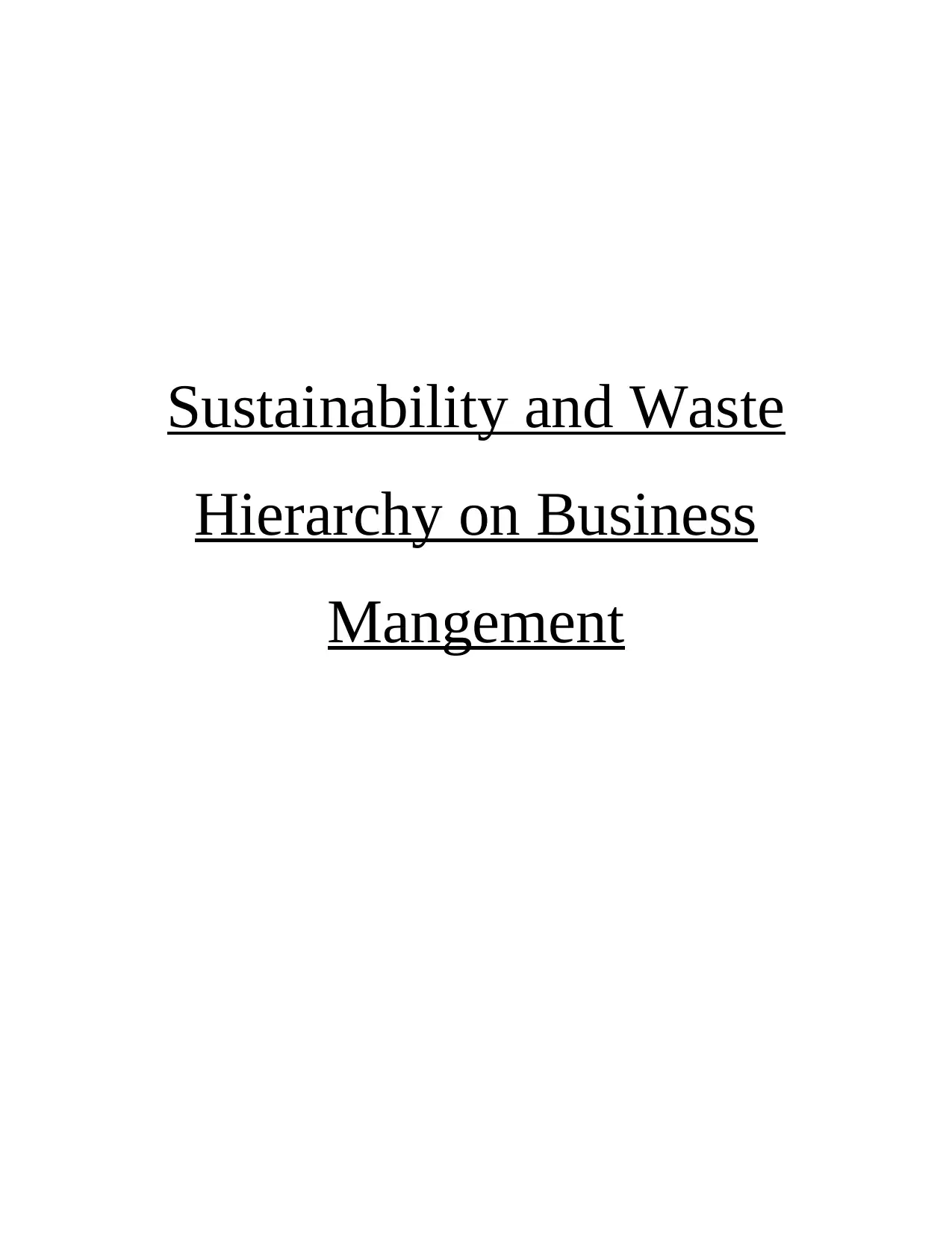
Sustainability and Waste
Hierarchy on Business
Mangement
Hierarchy on Business
Mangement
Secure Best Marks with AI Grader
Need help grading? Try our AI Grader for instant feedback on your assignments.
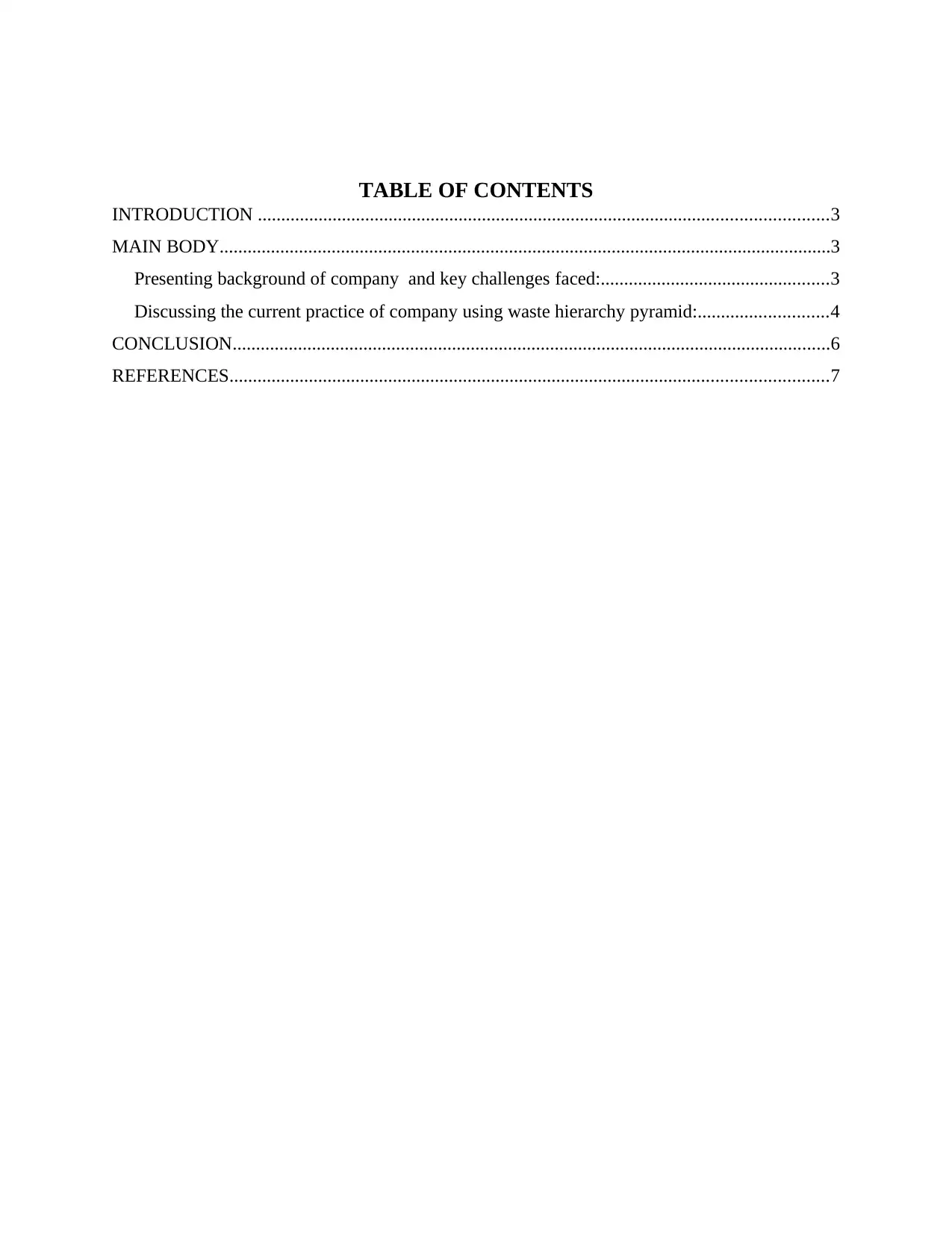
TABLE OF CONTENTS
INTRODUCTION ..........................................................................................................................3
MAIN BODY...................................................................................................................................3
Presenting background of company and key challenges faced:.................................................3
Discussing the current practice of company using waste hierarchy pyramid:............................4
CONCLUSION................................................................................................................................6
REFERENCES................................................................................................................................7
INTRODUCTION ..........................................................................................................................3
MAIN BODY...................................................................................................................................3
Presenting background of company and key challenges faced:.................................................3
Discussing the current practice of company using waste hierarchy pyramid:............................4
CONCLUSION................................................................................................................................6
REFERENCES................................................................................................................................7
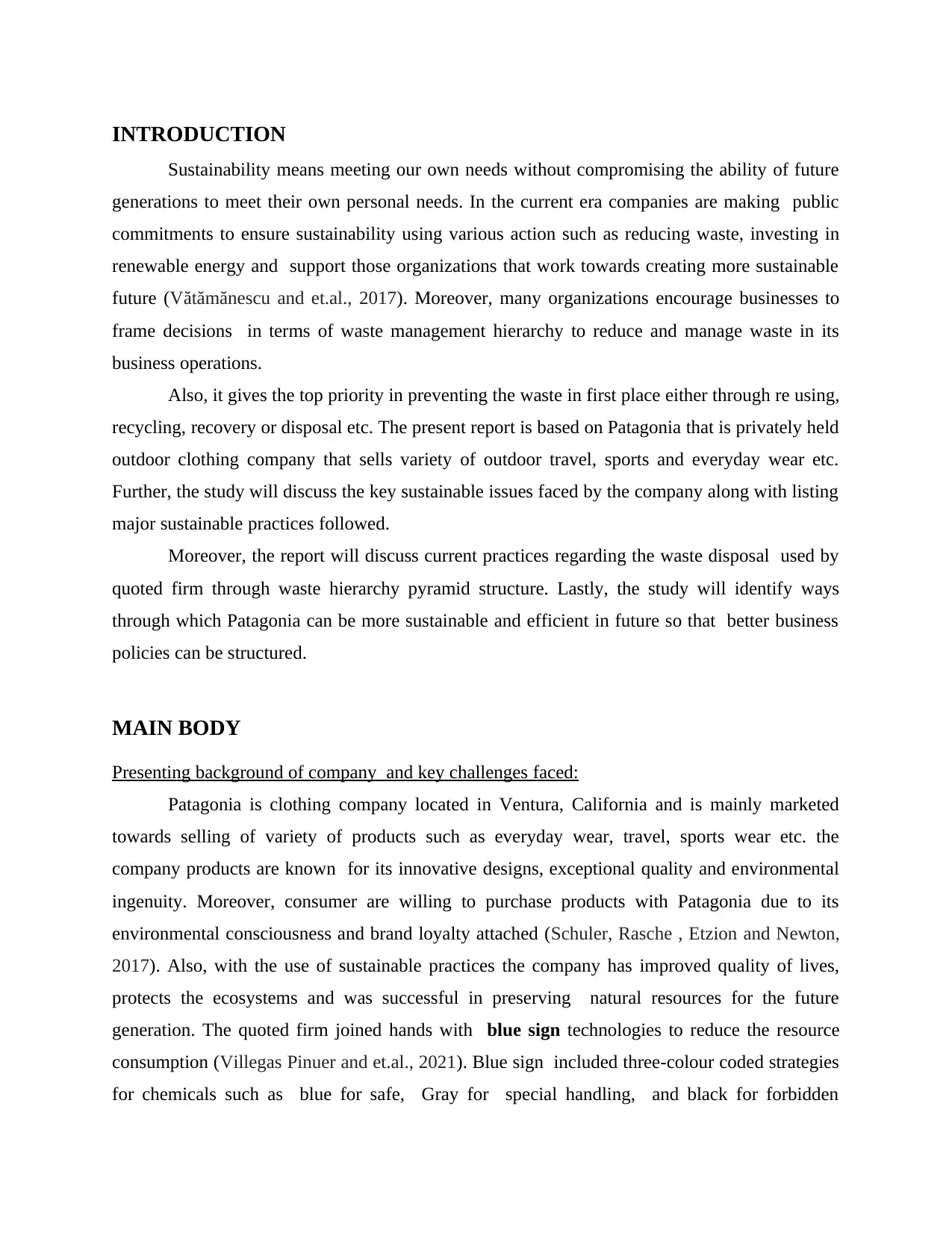
INTRODUCTION
Sustainability means meeting our own needs without compromising the ability of future
generations to meet their own personal needs. In the current era companies are making public
commitments to ensure sustainability using various action such as reducing waste, investing in
renewable energy and support those organizations that work towards creating more sustainable
future (Vătămănescu and et.al., 2017). Moreover, many organizations encourage businesses to
frame decisions in terms of waste management hierarchy to reduce and manage waste in its
business operations.
Also, it gives the top priority in preventing the waste in first place either through re using,
recycling, recovery or disposal etc. The present report is based on Patagonia that is privately held
outdoor clothing company that sells variety of outdoor travel, sports and everyday wear etc.
Further, the study will discuss the key sustainable issues faced by the company along with listing
major sustainable practices followed.
Moreover, the report will discuss current practices regarding the waste disposal used by
quoted firm through waste hierarchy pyramid structure. Lastly, the study will identify ways
through which Patagonia can be more sustainable and efficient in future so that better business
policies can be structured.
MAIN BODY
Presenting background of company and key challenges faced:
Patagonia is clothing company located in Ventura, California and is mainly marketed
towards selling of variety of products such as everyday wear, travel, sports wear etc. the
company products are known for its innovative designs, exceptional quality and environmental
ingenuity. Moreover, consumer are willing to purchase products with Patagonia due to its
environmental consciousness and brand loyalty attached (Schuler, Rasche , Etzion and Newton,
2017). Also, with the use of sustainable practices the company has improved quality of lives,
protects the ecosystems and was successful in preserving natural resources for the future
generation. The quoted firm joined hands with blue sign technologies to reduce the resource
consumption (Villegas Pinuer and et.al., 2021). Blue sign included three-colour coded strategies
for chemicals such as blue for safe, Gray for special handling, and black for forbidden
Sustainability means meeting our own needs without compromising the ability of future
generations to meet their own personal needs. In the current era companies are making public
commitments to ensure sustainability using various action such as reducing waste, investing in
renewable energy and support those organizations that work towards creating more sustainable
future (Vătămănescu and et.al., 2017). Moreover, many organizations encourage businesses to
frame decisions in terms of waste management hierarchy to reduce and manage waste in its
business operations.
Also, it gives the top priority in preventing the waste in first place either through re using,
recycling, recovery or disposal etc. The present report is based on Patagonia that is privately held
outdoor clothing company that sells variety of outdoor travel, sports and everyday wear etc.
Further, the study will discuss the key sustainable issues faced by the company along with listing
major sustainable practices followed.
Moreover, the report will discuss current practices regarding the waste disposal used by
quoted firm through waste hierarchy pyramid structure. Lastly, the study will identify ways
through which Patagonia can be more sustainable and efficient in future so that better business
policies can be structured.
MAIN BODY
Presenting background of company and key challenges faced:
Patagonia is clothing company located in Ventura, California and is mainly marketed
towards selling of variety of products such as everyday wear, travel, sports wear etc. the
company products are known for its innovative designs, exceptional quality and environmental
ingenuity. Moreover, consumer are willing to purchase products with Patagonia due to its
environmental consciousness and brand loyalty attached (Schuler, Rasche , Etzion and Newton,
2017). Also, with the use of sustainable practices the company has improved quality of lives,
protects the ecosystems and was successful in preserving natural resources for the future
generation. The quoted firm joined hands with blue sign technologies to reduce the resource
consumption (Villegas Pinuer and et.al., 2021). Blue sign included three-colour coded strategies
for chemicals such as blue for safe, Gray for special handling, and black for forbidden
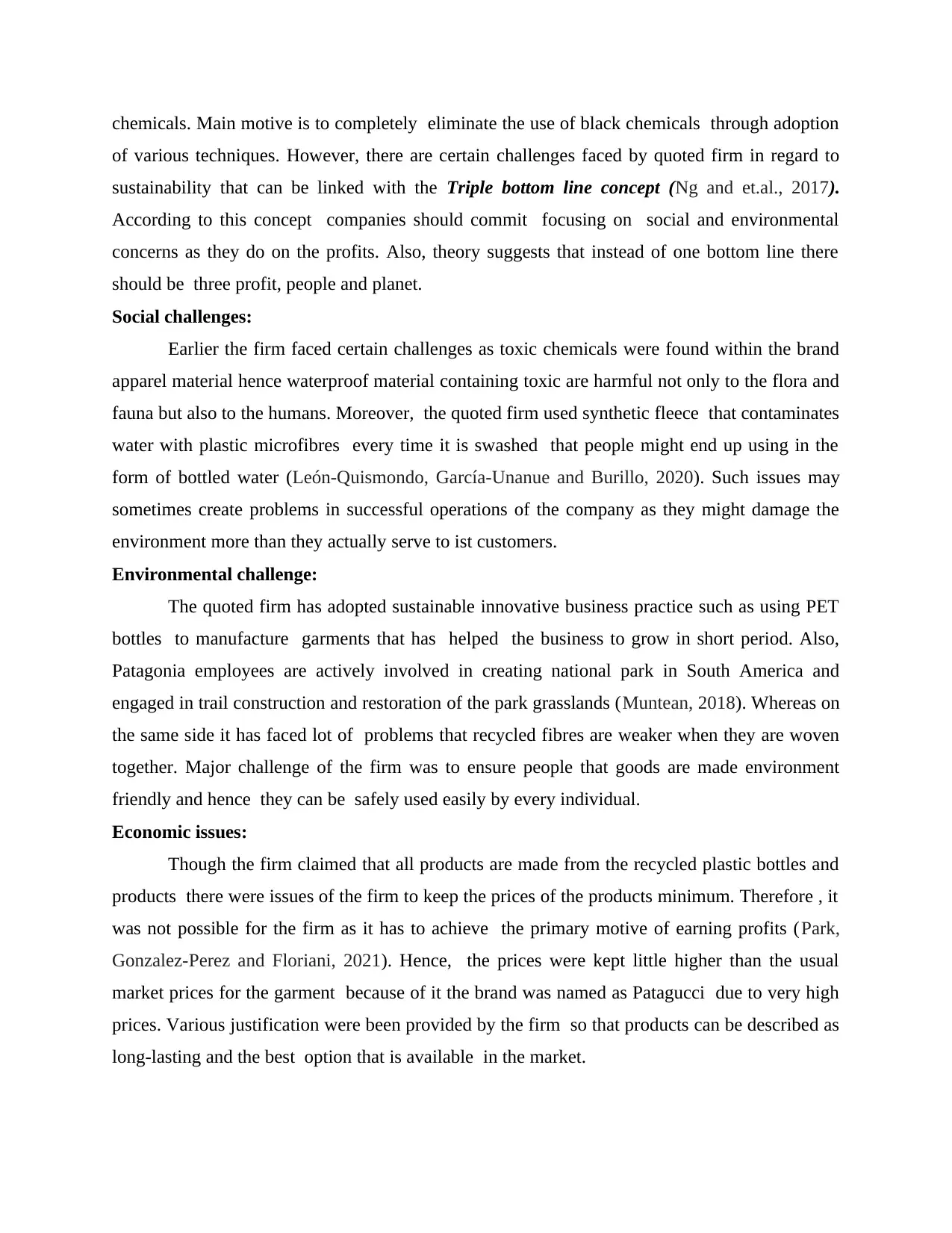
chemicals. Main motive is to completely eliminate the use of black chemicals through adoption
of various techniques. However, there are certain challenges faced by quoted firm in regard to
sustainability that can be linked with the Triple bottom line concept (Ng and et.al., 2017).
According to this concept companies should commit focusing on social and environmental
concerns as they do on the profits. Also, theory suggests that instead of one bottom line there
should be three profit, people and planet.
Social challenges:
Earlier the firm faced certain challenges as toxic chemicals were found within the brand
apparel material hence waterproof material containing toxic are harmful not only to the flora and
fauna but also to the humans. Moreover, the quoted firm used synthetic fleece that contaminates
water with plastic microfibres every time it is swashed that people might end up using in the
form of bottled water (León-Quismondo, García-Unanue and Burillo, 2020). Such issues may
sometimes create problems in successful operations of the company as they might damage the
environment more than they actually serve to ist customers.
Environmental challenge:
The quoted firm has adopted sustainable innovative business practice such as using PET
bottles to manufacture garments that has helped the business to grow in short period. Also,
Patagonia employees are actively involved in creating national park in South America and
engaged in trail construction and restoration of the park grasslands (Muntean, 2018). Whereas on
the same side it has faced lot of problems that recycled fibres are weaker when they are woven
together. Major challenge of the firm was to ensure people that goods are made environment
friendly and hence they can be safely used easily by every individual.
Economic issues:
Though the firm claimed that all products are made from the recycled plastic bottles and
products there were issues of the firm to keep the prices of the products minimum. Therefore , it
was not possible for the firm as it has to achieve the primary motive of earning profits (Park,
Gonzalez-Perez and Floriani, 2021). Hence, the prices were kept little higher than the usual
market prices for the garment because of it the brand was named as Patagucci due to very high
prices. Various justification were been provided by the firm so that products can be described as
long-lasting and the best option that is available in the market.
of various techniques. However, there are certain challenges faced by quoted firm in regard to
sustainability that can be linked with the Triple bottom line concept (Ng and et.al., 2017).
According to this concept companies should commit focusing on social and environmental
concerns as they do on the profits. Also, theory suggests that instead of one bottom line there
should be three profit, people and planet.
Social challenges:
Earlier the firm faced certain challenges as toxic chemicals were found within the brand
apparel material hence waterproof material containing toxic are harmful not only to the flora and
fauna but also to the humans. Moreover, the quoted firm used synthetic fleece that contaminates
water with plastic microfibres every time it is swashed that people might end up using in the
form of bottled water (León-Quismondo, García-Unanue and Burillo, 2020). Such issues may
sometimes create problems in successful operations of the company as they might damage the
environment more than they actually serve to ist customers.
Environmental challenge:
The quoted firm has adopted sustainable innovative business practice such as using PET
bottles to manufacture garments that has helped the business to grow in short period. Also,
Patagonia employees are actively involved in creating national park in South America and
engaged in trail construction and restoration of the park grasslands (Muntean, 2018). Whereas on
the same side it has faced lot of problems that recycled fibres are weaker when they are woven
together. Major challenge of the firm was to ensure people that goods are made environment
friendly and hence they can be safely used easily by every individual.
Economic issues:
Though the firm claimed that all products are made from the recycled plastic bottles and
products there were issues of the firm to keep the prices of the products minimum. Therefore , it
was not possible for the firm as it has to achieve the primary motive of earning profits (Park,
Gonzalez-Perez and Floriani, 2021). Hence, the prices were kept little higher than the usual
market prices for the garment because of it the brand was named as Patagucci due to very high
prices. Various justification were been provided by the firm so that products can be described as
long-lasting and the best option that is available in the market.
Secure Best Marks with AI Grader
Need help grading? Try our AI Grader for instant feedback on your assignments.
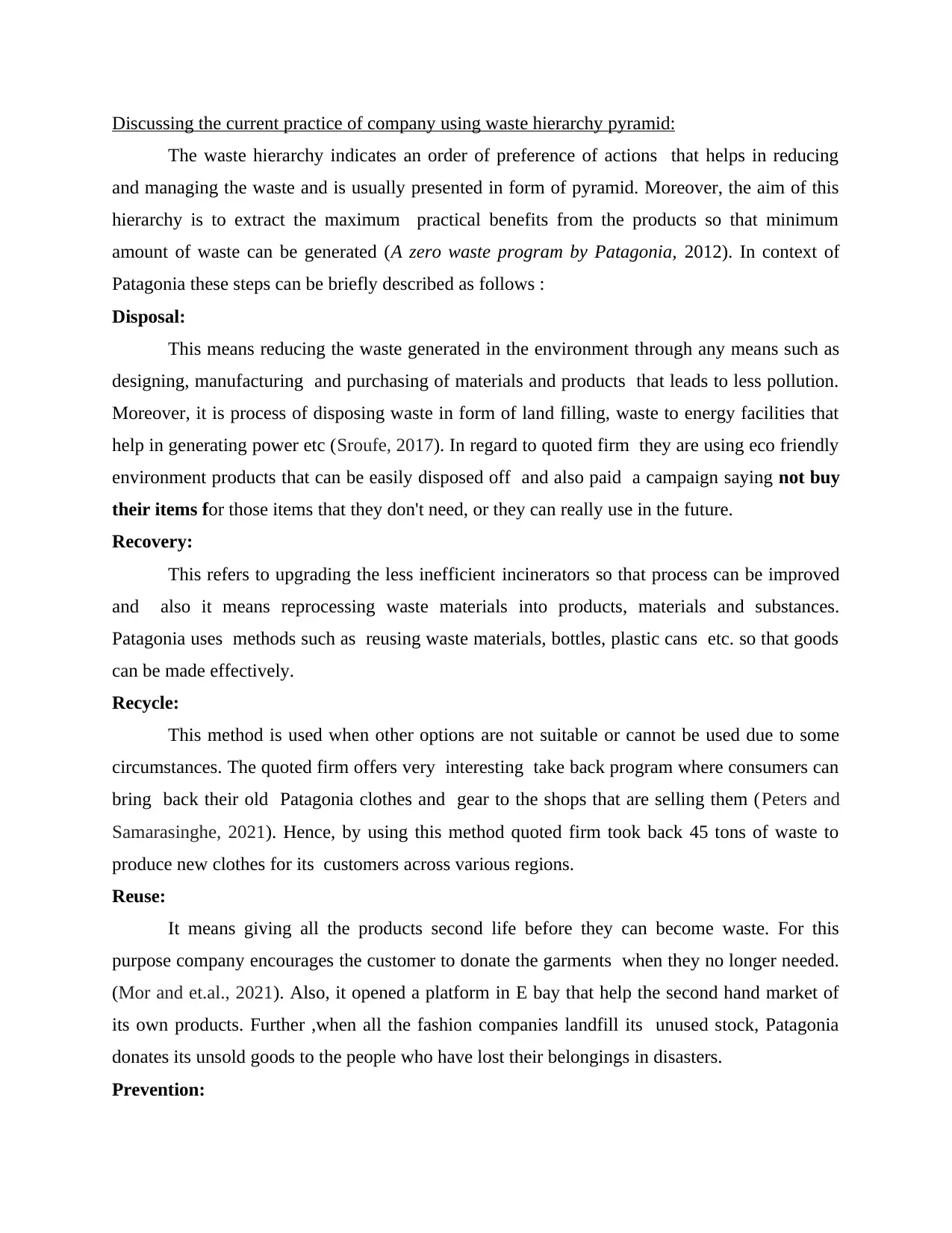
Discussing the current practice of company using waste hierarchy pyramid:
The waste hierarchy indicates an order of preference of actions that helps in reducing
and managing the waste and is usually presented in form of pyramid. Moreover, the aim of this
hierarchy is to extract the maximum practical benefits from the products so that minimum
amount of waste can be generated (A zero waste program by Patagonia, 2012). In context of
Patagonia these steps can be briefly described as follows :
Disposal:
This means reducing the waste generated in the environment through any means such as
designing, manufacturing and purchasing of materials and products that leads to less pollution.
Moreover, it is process of disposing waste in form of land filling, waste to energy facilities that
help in generating power etc (Sroufe, 2017). In regard to quoted firm they are using eco friendly
environment products that can be easily disposed off and also paid a campaign saying not buy
their items for those items that they don't need, or they can really use in the future.
Recovery:
This refers to upgrading the less inefficient incinerators so that process can be improved
and also it means reprocessing waste materials into products, materials and substances.
Patagonia uses methods such as reusing waste materials, bottles, plastic cans etc. so that goods
can be made effectively.
Recycle:
This method is used when other options are not suitable or cannot be used due to some
circumstances. The quoted firm offers very interesting take back program where consumers can
bring back their old Patagonia clothes and gear to the shops that are selling them (Peters and
Samarasinghe, 2021). Hence, by using this method quoted firm took back 45 tons of waste to
produce new clothes for its customers across various regions.
Reuse:
It means giving all the products second life before they can become waste. For this
purpose company encourages the customer to donate the garments when they no longer needed.
(Mor and et.al., 2021). Also, it opened a platform in E bay that help the second hand market of
its own products. Further ,when all the fashion companies landfill its unused stock, Patagonia
donates its unsold goods to the people who have lost their belongings in disasters.
Prevention:
The waste hierarchy indicates an order of preference of actions that helps in reducing
and managing the waste and is usually presented in form of pyramid. Moreover, the aim of this
hierarchy is to extract the maximum practical benefits from the products so that minimum
amount of waste can be generated (A zero waste program by Patagonia, 2012). In context of
Patagonia these steps can be briefly described as follows :
Disposal:
This means reducing the waste generated in the environment through any means such as
designing, manufacturing and purchasing of materials and products that leads to less pollution.
Moreover, it is process of disposing waste in form of land filling, waste to energy facilities that
help in generating power etc (Sroufe, 2017). In regard to quoted firm they are using eco friendly
environment products that can be easily disposed off and also paid a campaign saying not buy
their items for those items that they don't need, or they can really use in the future.
Recovery:
This refers to upgrading the less inefficient incinerators so that process can be improved
and also it means reprocessing waste materials into products, materials and substances.
Patagonia uses methods such as reusing waste materials, bottles, plastic cans etc. so that goods
can be made effectively.
Recycle:
This method is used when other options are not suitable or cannot be used due to some
circumstances. The quoted firm offers very interesting take back program where consumers can
bring back their old Patagonia clothes and gear to the shops that are selling them (Peters and
Samarasinghe, 2021). Hence, by using this method quoted firm took back 45 tons of waste to
produce new clothes for its customers across various regions.
Reuse:
It means giving all the products second life before they can become waste. For this
purpose company encourages the customer to donate the garments when they no longer needed.
(Mor and et.al., 2021). Also, it opened a platform in E bay that help the second hand market of
its own products. Further ,when all the fashion companies landfill its unused stock, Patagonia
donates its unsold goods to the people who have lost their belongings in disasters.
Prevention:
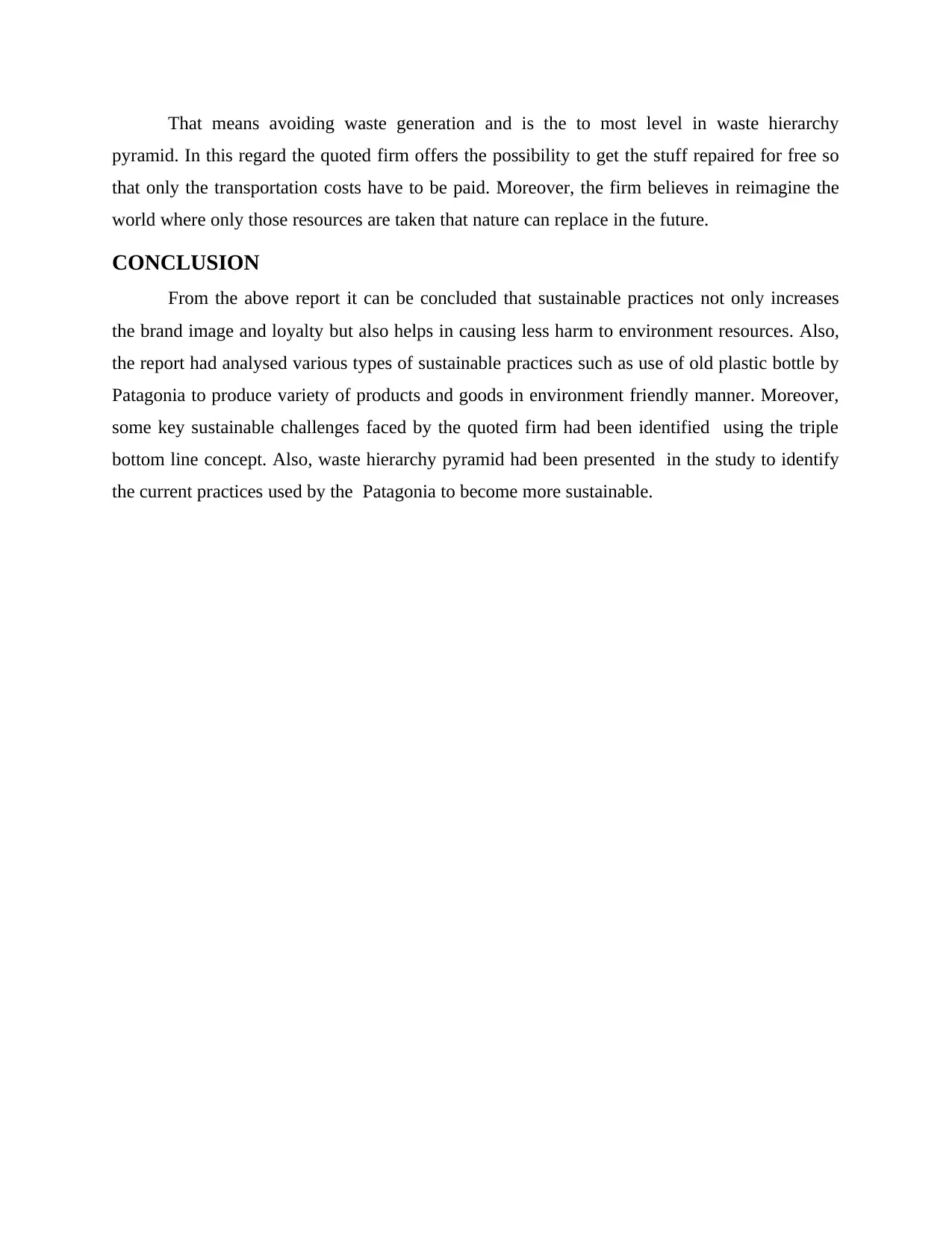
That means avoiding waste generation and is the to most level in waste hierarchy
pyramid. In this regard the quoted firm offers the possibility to get the stuff repaired for free so
that only the transportation costs have to be paid. Moreover, the firm believes in reimagine the
world where only those resources are taken that nature can replace in the future.
CONCLUSION
From the above report it can be concluded that sustainable practices not only increases
the brand image and loyalty but also helps in causing less harm to environment resources. Also,
the report had analysed various types of sustainable practices such as use of old plastic bottle by
Patagonia to produce variety of products and goods in environment friendly manner. Moreover,
some key sustainable challenges faced by the quoted firm had been identified using the triple
bottom line concept. Also, waste hierarchy pyramid had been presented in the study to identify
the current practices used by the Patagonia to become more sustainable.
pyramid. In this regard the quoted firm offers the possibility to get the stuff repaired for free so
that only the transportation costs have to be paid. Moreover, the firm believes in reimagine the
world where only those resources are taken that nature can replace in the future.
CONCLUSION
From the above report it can be concluded that sustainable practices not only increases
the brand image and loyalty but also helps in causing less harm to environment resources. Also,
the report had analysed various types of sustainable practices such as use of old plastic bottle by
Patagonia to produce variety of products and goods in environment friendly manner. Moreover,
some key sustainable challenges faced by the quoted firm had been identified using the triple
bottom line concept. Also, waste hierarchy pyramid had been presented in the study to identify
the current practices used by the Patagonia to become more sustainable.
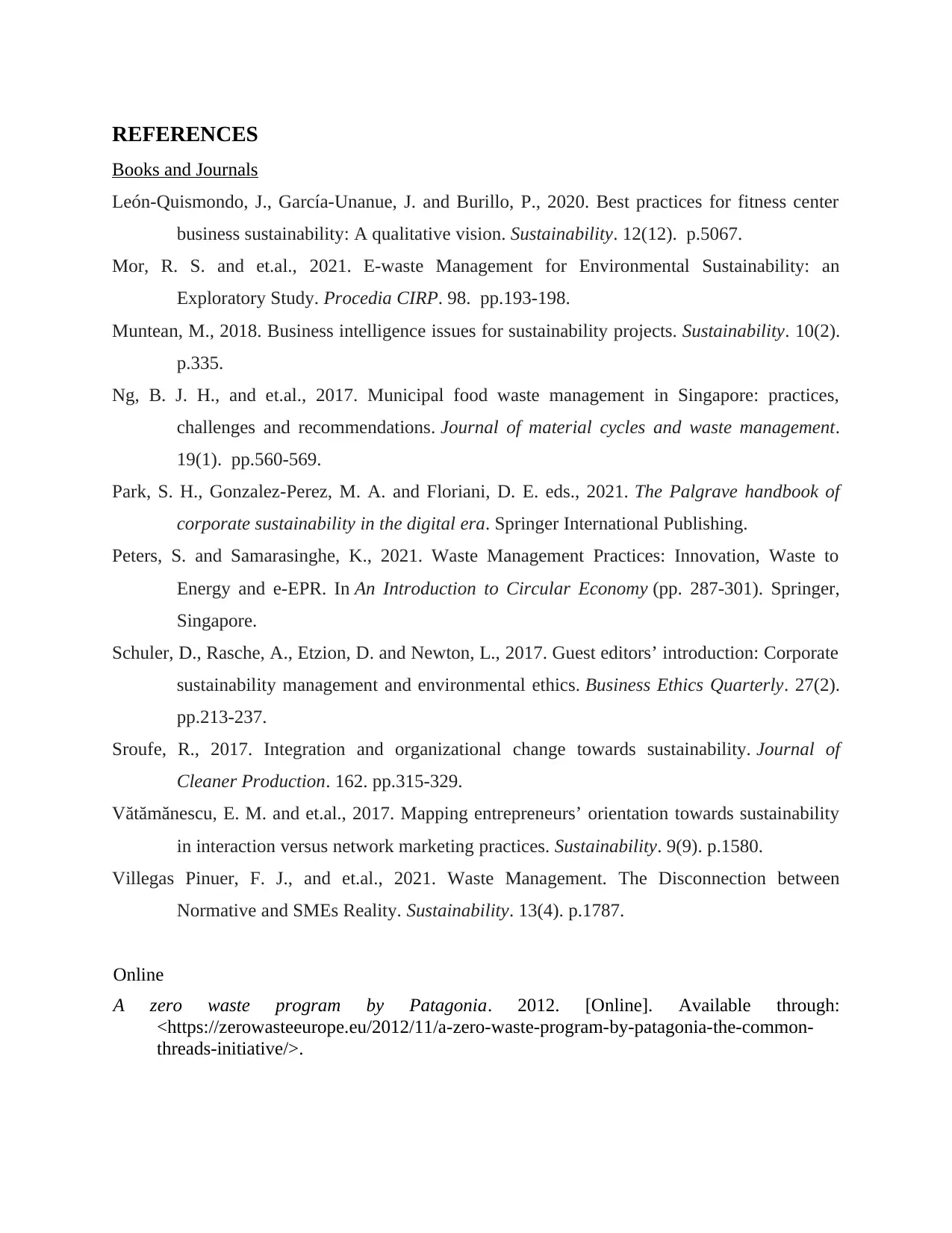
REFERENCES
Books and Journals
León-Quismondo, J., García-Unanue, J. and Burillo, P., 2020. Best practices for fitness center
business sustainability: A qualitative vision. Sustainability. 12(12). p.5067.
Mor, R. S. and et.al., 2021. E-waste Management for Environmental Sustainability: an
Exploratory Study. Procedia CIRP. 98. pp.193-198.
Muntean, M., 2018. Business intelligence issues for sustainability projects. Sustainability. 10(2).
p.335.
Ng, B. J. H., and et.al., 2017. Municipal food waste management in Singapore: practices,
challenges and recommendations. Journal of material cycles and waste management.
19(1). pp.560-569.
Park, S. H., Gonzalez-Perez, M. A. and Floriani, D. E. eds., 2021. The Palgrave handbook of
corporate sustainability in the digital era. Springer International Publishing.
Peters, S. and Samarasinghe, K., 2021. Waste Management Practices: Innovation, Waste to
Energy and e-EPR. In An Introduction to Circular Economy (pp. 287-301). Springer,
Singapore.
Schuler, D., Rasche, A., Etzion, D. and Newton, L., 2017. Guest editors’ introduction: Corporate
sustainability management and environmental ethics. Business Ethics Quarterly. 27(2).
pp.213-237.
Sroufe, R., 2017. Integration and organizational change towards sustainability. Journal of
Cleaner Production. 162. pp.315-329.
Vătămănescu, E. M. and et.al., 2017. Mapping entrepreneurs’ orientation towards sustainability
in interaction versus network marketing practices. Sustainability. 9(9). p.1580.
Villegas Pinuer, F. J., and et.al., 2021. Waste Management. The Disconnection between
Normative and SMEs Reality. Sustainability. 13(4). p.1787.
Online
A zero waste program by Patagonia. 2012. [Online]. Available through:
<https://zerowasteeurope.eu/2012/11/a-zero-waste-program-by-patagonia-the-common-
threads-initiative/>.
Books and Journals
León-Quismondo, J., García-Unanue, J. and Burillo, P., 2020. Best practices for fitness center
business sustainability: A qualitative vision. Sustainability. 12(12). p.5067.
Mor, R. S. and et.al., 2021. E-waste Management for Environmental Sustainability: an
Exploratory Study. Procedia CIRP. 98. pp.193-198.
Muntean, M., 2018. Business intelligence issues for sustainability projects. Sustainability. 10(2).
p.335.
Ng, B. J. H., and et.al., 2017. Municipal food waste management in Singapore: practices,
challenges and recommendations. Journal of material cycles and waste management.
19(1). pp.560-569.
Park, S. H., Gonzalez-Perez, M. A. and Floriani, D. E. eds., 2021. The Palgrave handbook of
corporate sustainability in the digital era. Springer International Publishing.
Peters, S. and Samarasinghe, K., 2021. Waste Management Practices: Innovation, Waste to
Energy and e-EPR. In An Introduction to Circular Economy (pp. 287-301). Springer,
Singapore.
Schuler, D., Rasche, A., Etzion, D. and Newton, L., 2017. Guest editors’ introduction: Corporate
sustainability management and environmental ethics. Business Ethics Quarterly. 27(2).
pp.213-237.
Sroufe, R., 2017. Integration and organizational change towards sustainability. Journal of
Cleaner Production. 162. pp.315-329.
Vătămănescu, E. M. and et.al., 2017. Mapping entrepreneurs’ orientation towards sustainability
in interaction versus network marketing practices. Sustainability. 9(9). p.1580.
Villegas Pinuer, F. J., and et.al., 2021. Waste Management. The Disconnection between
Normative and SMEs Reality. Sustainability. 13(4). p.1787.
Online
A zero waste program by Patagonia. 2012. [Online]. Available through:
<https://zerowasteeurope.eu/2012/11/a-zero-waste-program-by-patagonia-the-common-
threads-initiative/>.
1 out of 7
Related Documents
Your All-in-One AI-Powered Toolkit for Academic Success.
+13062052269
info@desklib.com
Available 24*7 on WhatsApp / Email
![[object Object]](/_next/static/media/star-bottom.7253800d.svg)
Unlock your academic potential
© 2024 | Zucol Services PVT LTD | All rights reserved.




